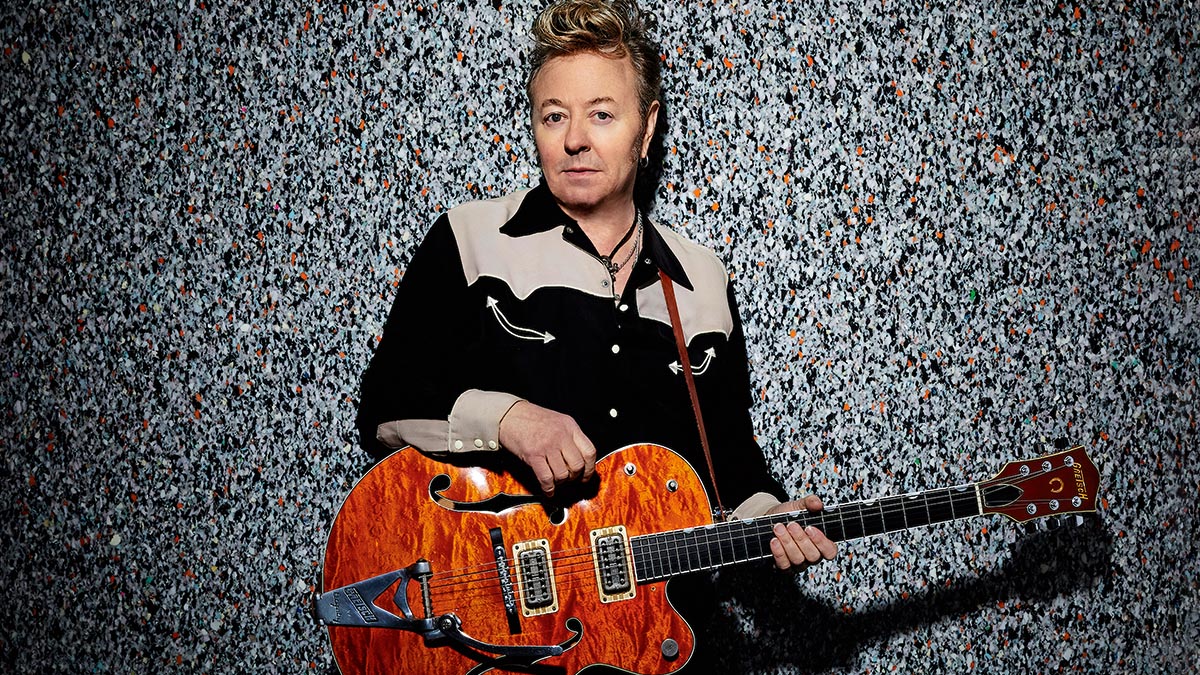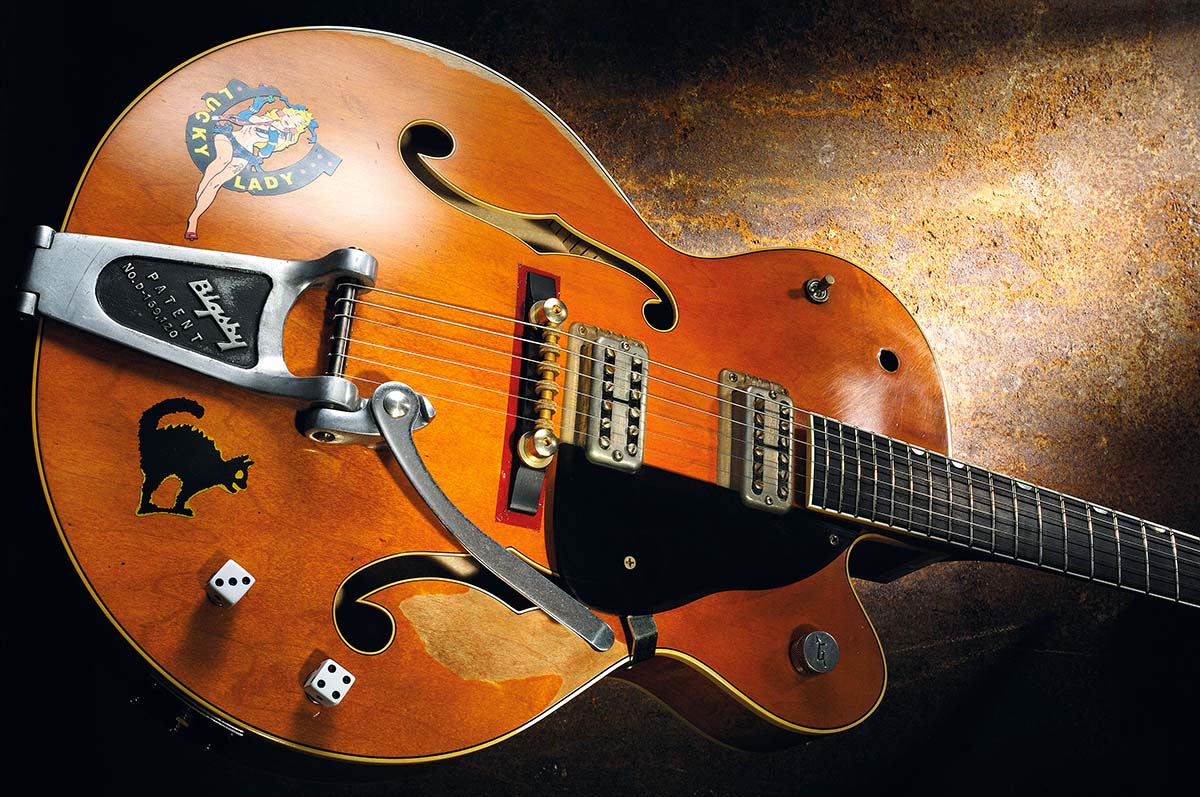Brian Setzer: “For guitar players, rockabilly is the best music you can play. You can do anything with it – you can inject jazz, country, blues into that style”
The rockabilly icon talks hot-rods, Gretsch, the importance of looking after your hearing, and explains why rockabilly requires a different skill-set from your traditional rock player

The years might roll by, but in Brian Setzer’s world, it is forever the '50s. There’s the quiff, still upstanding at 62. The rack of Gretsch antiquities, gleaming like the hubcaps of the hot-rods parked on his driveway.
The lyrics, exploring a hinterland of diners, drive-ins, jukeboxes and switchblades. The kingpin of modern rockabilly can even use the term ‘cat’, without irony, and pull it off.
But the image of an artist preserved in aspic doesn’t quite fit. Because while the twang is still the thang on the Stray Cats frontman’s new solo album, Gotta Have The Rumble, Setzer’s arrangements and voicings also give the ’billy a decisive nudge onwards.
“When I take a whole different genre and put it into my rockabilly world,” he tell us, “that’s what lights me up the most.”
What’s the significance of that album title, Gotta Have The Rumble?
“Of course, it’s a reference to my motorcycles, which give me my peace and quiet, believe it or not. That’s my meditation – I just hop on and ride. But then it became about the tinnitus I had going on and the bigger amps I had to use. So I thought, ‘Well, Gotta Have The Rumble, that refers to both things.’”

How bad was the tinnitus?
Get The Pick Newsletter
All the latest guitar news, interviews, lessons, reviews, deals and more, direct to your inbox!
“It was driving me mad. Everything was getting louder on stage. I’d say to [Stray Cats rhythm section, Slim] Jim [Phantom] and Lee [Rocker], ‘Are you guys turning up?’ ‘Nah, we’re just playin’, man.’ All of a sudden, it was like, ‘Ah, it’s the earplugs.’ They’d gone bad. It’s real and you have to address it.
“I saw an audiologist and I’m okay now, but for those people who don’t have it, imagine a tea kettle going off in your head, 24/7. Like, ‘Turn off the kettle!’ ‘It’s already off!’ Everything was starting to fall apart. The guitar, the amps and me had all pretty much fallen apart. We needed a break.”
If I could recommend to all your readers – please wear some earplugs, now
What emotions does that condition bring up for a guitar player?
“It’s horrible. Never mind thinking about playing music again. Playing was actually a relief because it would take your mind off it. It was the quieter times that drove you nuts, y’know, when you tried to sleep or just go for a peaceful walk. It goes on all the time. It’s maddening, is all I can say.
“If I could recommend to all your readers – please wear some earplugs, now. Because we didn’t wear ’em. Over the years, you didn’t question anything. You’re in the next town, there’s your guitar – get up there and rock ’n’ roll.”
What guitars did you bring into the studio?
“It’s pretty much all Gretsch. Because I find if I stray from my Gretsch arsenal, it doesn’t sound like me. But here’s the thing. I’m looking at three vintage Gretsch guitars right now. One doesn’t play in tune. One has scratchy pickups. On the other, the Bigsby is broke, right?
“But when I get the itch and I want to go down to the studio, I don’t want to mess around. So I have a newer black 6120 Setzer model – it’s maybe four years old – and it plays so well. I picked up a ’59, too, but when I plugged them both in, I preferred the new one. So I played that Setzer model on most of the tracks you hear. Some of them are a ’59, and on Turn You On, Turn Me On, that’s an old Duo Jet.”
As a kid, listening to the radio, I felt like the most important thing was to have your own tone
Why does Gretsch cast such a spell over you?
“As a kid, listening to the radio, I felt like the most important thing was to have your own tone. At that time, I was hearing Eric Clapton, Creedence Clearwater Revival – and I knew those players right away because of the guitar tone. So even back then, I realised, I gotta get that together.
“A Gibson, to me, was too muddy; I didn’t want that tone. And a Fender, to me, was too thin. But the Gretsch was right in between them. It got the twang of the Fender and the fatness of the Gibson. It fit perfectly for me.”
The Tele seems like it’d be great for rockabilly, too. Don’t you like them?
“I do like Telecasters. But it’s funny with guitars: I like the way other people play ’em. I’ve always been fascinated with the looks of a Stratocaster. I love the way they look. They’re mid-century modern art. Y’know, it looks like an old '50s coffee table. But I can’t play ’em. I don’t like the scale. It’s got the middle pickup and the volume knob right in the way. I love the way other people play ’em, I just can’t get a sound out of ’em.”
Part of the sound for me on the Gretsch is that I play with that extra gain... moving around the amp, you can play with sustain, you can play with overtones
Are the Gretsches worth the feedback?
“I’ve never gotten a feedback out of ’em that I can’t control. Part of the sound for me on the Gretsch is that I play with that extra gain. The sound comes back through the guitar, through the f-holes, so moving around the amp, you can play with sustain, you can play with overtones.
“That’s why I never needed anything like an overdrive pedal. Because if I wanted a little more gain, I’d just stand closer to the amp. And then, if I wanted it to be more twangy, I’d just turn away from the amp. So I didn’t need pedals.”
How did the tinnitus affect your amp choice this time?
“I started out with smaller amps. But they just didn’t have the rumble. So I went back to my tried-and-true ’63 Bassmans. Those things are loud. And it was like, ‘There it is!’ I also used the vibrato on an old Fender Bandmaster, and a Deluxe Reverb for the rockabilly traditional. Those three amps pretty much knocked it on the head.”
You’re not alone in your obsession with cars and guitars; think Billy Gibbons and Jeff Beck. What’s the appeal?
“Jeff can build those damn hot-rods from scratch. He almost cut off the tip of his finger once. I said to him, ‘You’ve gotta remember what’s most important here!’ With the hot-rods, it’s about individual expression. There’s no two hot-rods the same.
“You’re not just going out and buying a new Bentley. That only takes money. Hot-rods, you’ve got to create it and then you get to ride around in that thing. It’s like rolling art. For me, also, with the motorcycles and the cars, it’s adrenaline. It’s about going fast. It gives me that rush.”
If you’ve got the car, you got the guitar and you got the gal – you got the whole package
What role does the car play in rockabilly history?
“I think it started with the blues, people talking about their new car. Again, it’s your personal expression. Especially with the rockabilly music, it goes with the whole lifestyle. Because if you’ve got the car, you got the guitar and you got the gal – you got the whole package.
“The only all-car album I can think of is The Beach Boys when they did Little Deuce Coupe [1963]. That entire album was about cars. I don’t know if there’s anything like that in rockabilly. But there’s enough songs to pick and choose.”
What’s more impressive – your car collection or your guitar collection?
“Here’s the thing. I don’t have anything I don’t use. I don’t have wall-hanger guitars or closet guitars. I don’t have, certainly, the money or the time for a big car collection. I can pretty much get by with what I work on, and that’s my rule of thumb: if I don’t play it or I don’t ride it, I don’t have it.”
You’ve said the inspiration for Smash Up On Highway One was Dick Dale.
“Yeah, that’s true. When the Stray Cats toured in 2019, I was playing Misirlou. I really liked the Eastern hook of that track. I thought, ‘Man, I’d like to write something like that.’ So I came up with that crazy lick. I don’t know what scale it is, actually. It’s a mode, but I don’t think it’s exact – it probably has a note or two changed.
“Maybe one of your readers can weigh in on that. The idea was to insert that into my sound, which is the rockabilly base. Then there’s The Cat With 9 Wives: the note in that lick should be an E, but I play an Eb, which I thought was kinda clever. It’s kind of a passing tone. That’s how you keep the whole thing fresh – you keep inventing things.”

Do you think there’s a correlation between rockabilly and surf music?
“It’s interesting you say that. I know a lot of rockabilly musicians and they’re really influenced by the surf music. There does seem to be an overlap in the guitar tone, with the reverb. The Ventures’ Live In Japan ’65 – my God, it’s fantastic.”
How did you get that amazing tone on Stack My Money?
“Isn’t that a good sound? The hardest sound to get, for me, is a strong, clean tone, without it breaking up or being plunky. Back in the day, Chet Atkins was always after that – he wanted a clear sustain. We got that tone quite by accident. I used the Deluxe Reverb, an early '60s one, y’know, the blackface with the one speaker. And by accident, we left the vocal mic on.
“It was way distant, right? I came in and I played, and I was like, ‘Wow, that’s just what I’m looking for.’ And the engineer said, ‘Wait, I just gotta turn off the vocal mic.’ When he turned off the vocal mic, the sound went away. It was like, ‘Put that vocal mic back on!’ – and it happened again. So, trial and error.”
The arrangement of The Wrong Side Of The Tracks is really sophisticated.
“That ain’t rockabilly. That could be a theme song from a '50s rockabilly movie, with the strings and chord changes. But there wouldn’t be a blues or rockabilly musician who would have written that. That’s more like something you would hear from Elmer Bernstein. I’m not comparing myself to one of those composers. But that’s a soundtrack that I made into a rockabilly song. It’s got sophisticated chord work, but I made it fit into my world.”
Rockabilly comes from the heart. It speaks to you. It’s like the blues. But, to me, it’s much more exciting than the blues. It’s sexy
When you think about the architects of rockabilly guitar technique from the '40s and '50s, who do you regard most highly?
“For me, there’s two guys – and then there’s a hundred guys you’ve never heard of. Let me start with the hundred guys you’ve never heard of. Because the hundred guys who did a great guitar solo in the '50s, they came out of the hills, or they drove a truck for a living. And they had one song, and they drove to a little studio in Memphis or somewhere, and they made the song – and if it wasn’t a hit, they were back driving the truck. And you’d go, ‘Who was that?’ Nobody knows.
“Like, who played the guitar solo on Red Hot? I know it was Roland Janes. But nobody knows who that is. Nobody really knows who the two popular guys who most affected me are – Scotty Moore and Cliff Gallup. I’m sure if you asked 90 per cent of today’s guitar players, they might not know those two. But they were the most consistent guys, the two who kept coming up and hitting the ball out of the park.”
If you could set the controls of a time machine to any city and scene, where would you go?
“I’d go back to Memphis in ’56. You have to remember how conservative our societies were back then. To be making that music back then – to be really shaking it up – it must have been incredible.”
Why does rockabilly have such an enduring appeal?
“Because it comes from the heart. It speaks to you. It’s like the blues. But, to me, it’s much more exciting than the blues. It’s sexy. It has the whole musical package. It has the style. It has pizazz. It’s not about combing your hair a certain way or wearing a certain outfit. It gets something going inside you. And for guitar players, it’s the best music you can play. You can do anything with it. You can inject jazz, country, blues, into that style.”
I guarantee you that 99 per cent of the rock guys could not play rockabilly
Do you think rockabilly players need a whole different skill set? Could a rock guitarist play this stuff?
“Well, let’s just take two generic guys. If you take a generic rocker and tell him to play rockabilly, no. Because the rockabilly players are versed more in fingerpicking, which comes from Chet Atkins, and single-string solos, which come from people like Charlie Christian, they come from jazz.
“I guarantee you that 99 per cent of the rock guys could not play rockabilly. Could it go the other way? Yeah, I think it could. Because rock music is more based on chords, and single-string riffs that are based on a pentatonic scale. So without being a snob, I don’t think the rock guys could do the ’billy.”
- Gotta Have That Rumble is out now via Surfdog/Mascot Label Group.
Henry Yates is a freelance journalist who has written about music for titles including The Guardian, Telegraph, NME, Classic Rock, Guitarist, Total Guitar and Metal Hammer. He is the author of Walter Trout's official biography, Rescued From Reality, a talking head on Times Radio and an interviewer who has spoken to Brian May, Jimmy Page, Ozzy Osbourne, Ronnie Wood, Dave Grohl and many more. As a guitarist with three decades' experience, he mostly plays a Fender Telecaster and Gibson Les Paul.
“I suppose I felt that I deserved it for the amount of seriousness that I’d put into it. My head was huge!” “Clapton is God” graffiti made him a guitar legend when he was barely 20 – he says he was far from uncomfortable with the adulation at the time
“I was in a frenzy about it being trapped and burnt up. I knew I'd never be able to replace it”: After being pulled from the wreckage of a car crash, John Sykes ran back to his burning vehicle to save his beloved '76 Les Paul











